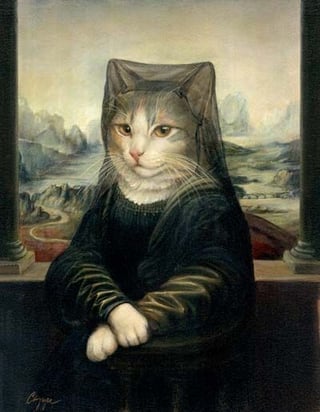This post is written by Mary Chase, Ph.D., an expert in curriculum design, literacy education, and technology integration.
In my previous post, I explained that reading depends on three cueing systems. As students create knowledge maps of the text they encounter, they not only break down meaning, but also encode it in their memories using all three cueing systems. There's more, though. Ideaphora's visual/verbal mapping environment helps learners tap into the power of dual coding, a cognitive theory proposed by Alan Paivio. Let me illustrate.
Take a look at this image:

Despite enormous differences, most of us immediately recognize it as a parody of Leonardo da Vinci’s Mona Lisa. However, the way the brain processes images and text separately, and more importantly together, differ.
Consider the following passage as well:
The painting, thought to be a portrait of Lisa Gherardini, the wife of Francesco del Giocondo, is in oil on a white Lombardy poplar panel, and is believed to have been painted between 1503 and 1506. Leonardo may have continued working on it as late as 1517. It was acquired by King Francis I of France and is now the property of the French Republic, on permanent display at the Louvre Museum in Paris since 1797.
The subject's expression, which is frequently described as enigmatic, the monumentality of the composition, the subtle modeling of forms, and the atmospheric illusionism were novel qualities that have contributed to the continuing fascination and study of the work.
Even though the description includes many details about the painting, its subject is not identifiable as Mona Lisa in the passage alone without some thought and a distinct kind of prior knowledge. Moreover, it takes much more time to decipher the text’s meaning. The reason for this? Images encode in the brain in their entirety and text must be attended to word by word, phrase by phrase.
Alan Paivio’s dual coding theory suggests that there are two cognitive subsystems, one specialized for imagery and the other for language. Images and words are separate, but interrelated, codes. They can be activated independently, but when interconnected, information is “dual coded,” with image code more effective than verbal by as much as a 2:1 ratio. This means that information that is interconnected verbally and visually permits cueing from one system to the other. This, in turn, facilitates making connections, understanding relationships, and recalling related details.
When students use Ideaphora to blend visual and verbal information by creating concept maps, their understanding and recall expand beyond what mere reading allows.
How about testing this theory? Try working with another teacher using the same text. Assign reading the material to both classes. One class will only read the material. The other class will read, and then use Ideaphora to map the information. Administer the same test of recall to both classes and see the results. And please—let us know how it goes!
To use Ideaphora with your students for free, enroll in the Classroom Pilot Program.

